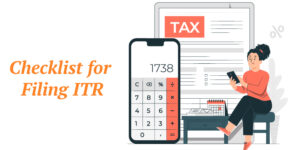 Tax filing season is approaching, plan ahead to avoid last-minute hassles. Check ITR form eligibility, residential status, choose tax regime wisely, maintain proper documentation and more.
Tax filing season is approaching, plan ahead to avoid last-minute hassles. Check ITR form eligibility, residential status, choose tax regime wisely, maintain proper documentation and more.
Tax filing season is coming and just like summer individuals must plan to beat the heat. To avoid last-minute hassles and make sure that tax benefits and claims are correctly reported and documentation is proper, enclosed below is a ten-point checklist.
Selecting the correct ITR form: Choose the appropriate ITR form for the FY 23-24 based on the criteria summarised below.
| ITR Form | When are you eligible? | When are you ineligible? |
| ITR – 1 |
§ salary/pension, § one house property § other sources § Agricultural income < ₹5k |
If you are a Non-resident
If you are a director in a company If you hold unlisted equity shares If you have more than one house If your Agricultural income > ₹5k If you have foreign income or assets |
| ITR – 2 | If you are not eligible to file ITR-1 and where you do not have any business or professional income | If you have any income from business or profession |
| ITR – 3 | If you have business income or professional income
If you are not eligible to file ITR 1, ITR 2 or ITR 4 |
None |
| ITR – 4 | Resident Individuals with a total income of up to ₹50 Lakhs including business income computed as per presumptive taxation. | Similar to ITR 1 |
Residential status determination: This determination of residential status is based on your physical presence in India.
You would be a resident in India if you satisfy either of the two basic conditions:
(a) Stay in India is ≥ 182 days in FY 23-24.
(b) Stays in India is ≥ 60 days** in FY 23-24 and ≥ 365 days in the preceding 4 years.
In the case of an Indian citizen who leaves India for employment, 60 days get replaced by 182 days. For an Indian citizen or PIO coming on visits to India, 60 days get replaced by 120 days (for individuals with an Indian source income of more than 15 lacs) and 182 days in other cases.
To qualify as not ordinarily resident, assess if you meet any one of these secondary conditions:
To qualify as an ordinary resident, you must not meet any of the secondary conditions.
If you are an Indian citizen settled abroad and a non-resident as per the basic conditions, you could be treated as a ‘deemed resident’ when you have an income ₹15 lakhs from Indian sources.
Residential status is relevant to determine the scope of income, applicable tax rates, and eligible tax treaty benefits.
Choosing between tax regimes: Unless you have already made this choice, this is your final opportunity to evaluate whether to opt for the new default tax regime or stick with the earlier regime. Form 10IE is mandatory if you opt out of the new regime when you have a business income.
Download 26AS and AIS: Do not forget to download the latest updated AIS and Form 26AS for FY 2023-24 and cross-verify your income and credit of taxes claimed with the one reported in your tax return.
Documentation for income sources: Key supporting documents to be maintained:
Clubbing of family member’s income: If you have minor kids, who have any income from investments, do not miss having their income documents and club their income in your return. Further, keep track of the income of your spouse from gifted assets and consider this in your return.
Foreign tax credit and tax residency certificate: If you are a resident individual, you can claim credit for foreign taxes on your doubly taxed foreign income. Evaluate treaty conditions, and timely file Form 67 along with foreign tax payment proofs.
If you are a non-resident, ensure obtaining a tax residency certificate from the Foreign Regulators and evaluate the filing of Form 10F to claim treaty benefits.
Details to complete some key schedules: Details of assets and liabilities are needed if your income exceeds ₹50 lakh. Do not forget to disclose directorship details and any unlisted equity shares owned during the year.
Schedule FA: Mandatory for ordinary residents, detailing foreign assets and income. Jointly owned properties, properties with beneficial interest, and the signatory in foreign bank accounts and foreign trusts are some of the mandatory disclosures in Schedule FA.
This checklist can help you prepare for timely tax filings and enable you to navigate the filing process smoothly. This will also smoothen the process of responding to any inquiries. Stay proactive, stay informed, and approach the tax season with confidence!
Source: https://www.livemint.com/money/personal-finance/income-tax-return-how-to-prepare-for-hassle-free-tax-compliance-here-is-a-10-point-checklist-tax-filing-itr-11714108865341.html
© 2018 CA Chandan Agarwal. All rights reserved.